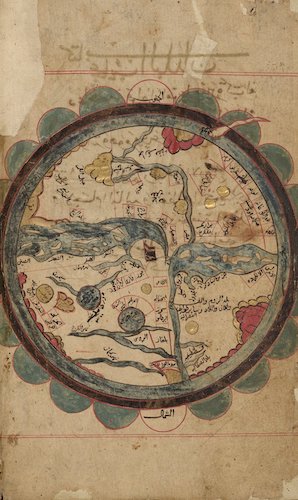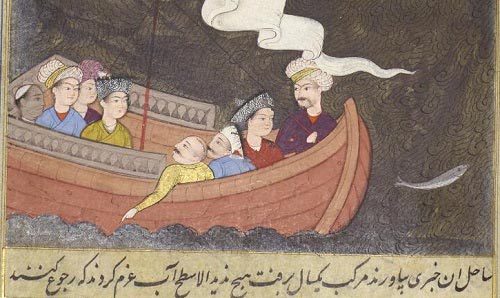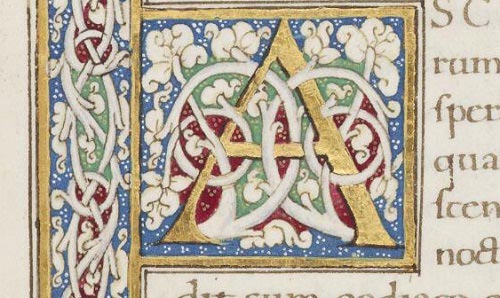
Middle East Collections
The Library holds an internationally significant collection of Middle Eastern manuscripts, complemented by smaller collections of manuscripts from Central Asia and some notable print and archive materials.

The collections are strong in areas as diverse as the ancient Near East, medieval Arab history and religion, Persian literatures and art, Rabbinic discourse, Ottoman diplomacy, and the Arab-Israeli conflict.
Manuscript collections provide in-depth coverage of religion (especially the Abrahamic faiths), literature, visual arts and history. They include documents as well as books in a variety of formats, languages and scripts, ranging from ancient cuneiform tablets to digitised newspapers. The substantial collections of manuscripts in Arabic, Persian, Hebrew, Samaritan and Coptic are particularly significant. These manuscripts, together with the papyri and Cairo Genizah fragments, shed light on the social, commercial, political, religious and intellectual life of the Middle East from the ancient world to the 19th century.
Printed holdings complement the manuscripts, encompassing Arabic and Hebrew works printed in Renaissance Italy, early Middle Eastern regional printing and Jewish literature and theological texts. A wide variety of collections document changing relationships between the Middle East and Europe, most notable are archives relating to the Arab-Israeli conflict.
Ancient Mesopotamia and Egypt
More than a thousand Sumerian and Akkadian clay tablets in cuneiform script document everyday life and culture in Ancient Mesopotamia. Most date from the Ur III dynasty (22nd-21st centuries BCE), but there are some earlier and later Babylonian and Assyrian pieces. Predominantly from the great temples of Drehem and Umma, the tablets include royal inscriptions, letters, economic, administrative and agricultural documents and literary texts.
The Library holds an important collection of Egyptian papyri and ostraca in hieroglyphic, hieratic and demotic scripts, dating from 14th century BCE-2nd century CE. Some are funerary texts, including the Book of the Dead, but the majority are documentary sources revealing details about the lives of individuals and communities in Egypt, especially in the area around Hermopolis (now El Ashmunein). Other substantial papyri collections preserve texts written in Greek, Coptic and Arabic, with smaller numbers in Latin and Hebrew. The Graeco-Roman papyri are especially significant and contain important religious, literary and documentary texts.
Religions and theology
The history and literature of Islam are well represented in the Rylands. Large collections of Arabic and Persian manuscripts, and a smaller collection of Pashto (Afghan) manuscripts, cover many dimensions of Islamic theology and practice. The substantial Arabic collections encompass Qur'ānic manuscripts from the 8th century CE onwards, theological texts and amulets. The Persian and Turkish manuscripts (including Ottoman Turkish and Chagatai) also contain theological and religious texts. Highlights include a 15th-century multi-volume Qu'rān in Arabic with Persian and Chagatai translations and a monumental Mamluk Qur’ān from 14th-century Egypt, weighing in at 52 kilos.
Christianity in the Middle East is another strength of our manuscript and papyrus collections. Early Christian texts are an important feature of the Greek papyrus collection (largely from Egypt), which includes one of the earliest known fragments of the New Testament and a substantial number of other important canonical and non-canonical texts. Collections of manuscripts in Coptic, Syriac (including Karshuni), Arabic, and Armenian contain notable examples of written and visual culture from a variety of Christian traditions.
The Rylands holds some of the earliest written evidence of Judaism in the Middle East. The famous ‘Deuteronomy fragments’ come from an Egyptian papyrus roll written in Greek in the 2nd century BC. The Reed Collection documents the material analysis of the Dead Sea Scrolls in the 1950s and 60s, including tiny samples from the scrolls themselves. The Cairo Genizah Collection contains over ten thousand fragments on parchment and paper relating to Jewish faith, culture and history from the 10th-19th centuries CE. The wider collections encompass Samaritan, Hebrew and Judeo-Arabic manuscripts and amulets, Hebrew incunabula and early Bibles printed in Hebrew. The printed Marmorstein and Teltscher collections are rich in classical rabbinic texts and in East European responsa. For the Jewish enlightenment see the Haskalah Collection, while the Teltscher Archive deals with Judaism, Jewish history and the practice of Judaism.
The Library’s small but important collection of Zoroastrian (‘Parsi’) manuscripts comprises copies of the Avesta, alongside religious, literary, historical and astrological texts. Primarily copied in Iran and India during the 14th-19th centuries, they encompass a variety of languages (including Avestan, Middle Persian, Farsi, and Gujarati) and a variety of scripts (including Pahlavi, Nagari, Arabic and Pazend). The large Persian Manuscripts collection also contains Zoroastrian texts.
Arts and culture
Islamicate art and culture is represented extensively in the Rylands collections, particularly in the Arabic, Persian, Turkish and Pashto (Afghan) manuscripts. The subject range is vast, from literature and music, to medicine and sport. Although most manuscripts derive from the Middle East and South Asia, their geographical range illustrates the reach of Islam and Islamicate culture from West Africa to Southeast Asia. The Arabic manuscripts comprise almost 900 codices, some 800 papyri and approximately 1,500 paper fragments, from the 8th-19th centuries CE. The Persian manuscripts comprise almost 950 codices from the 13th century onwards, many superbly illuminated and illustrated with the finest miniature paintings, or lavishly bound. A small but important collection of albums of Persianate painting and calligraphy from Iran and India awaits scholarly investigation.
The manuscript collections also provide a good representation of book art from Christian and Jewish cultures of the Middle East. These include illustrated and illuminated Armenian, Coptic and Syriac manuscripts, as well as significant examples of Jewish and Samaritan book art and material culture.
General printed book holdings also include important examples of Middle Eastern print culture, from the first book printed with Arabic movable type in 1514 and other Arabic works printed in Renaissance and Enlightenment Europe, to early Middle Eastern regional printing (including examples from the Muteferrika Press), and lithographs printed in Egypt, Iran and India.
The Rylands holds many works in translation throughout our manuscript, archive and printed book collections. Translations and multi-lingual versions of the Bible and the Qu’rān are particularly well represented. The Carcanet Press Archive contains correspondence and drafts relating to the work of several modern Middle Eastern writers and literary translators, including Orhan Pamuk and Latife Tekin. Other materials relating to the study of language and translation include grammatical and lexicographical works in a range of languages, and research papers of scholars from Sir William Jones (1746-1794) to University of Manchester academics.
History of the Middle East and Central Asia
The collections contain hundreds of histories written in Arabic, Persian and Turkish. These manuscripts and printed books include mythological renderings, dynastic and scholarly histories covering geographical areas including Egypt, Iran, Yemen and Syria, and the world, including important copies of the famous Iran epic, the Shahnama (Book of Kings). There are many historical documents among the papyrus collections and Cairo Genizah fragments, and smaller numbers among the manuscripts, including an important volume of Arabic and Ottoman Turkish papers compiled by the Dutch scholar Johannes Heyman (1667–1737).
The Guardian Archive is a rich source for the history of the Middle East and Central Asia in the 19th-20th centuries, from the Crimean War to the Suez Crisis. The Hibbert-Ware and Stanley Family Papers preserve personal accounts of British experiences during the Crimean War. Important documents relating to the Zionist pioneer Chaim Weizmann and the founding of Israel can be found in the Guardian Archive and in the papers of Samuel Alexander and W. P. Crozier. More recently, the Dorman O’Gowan Papers and Mabel Tylecote Collection document the Arab-Israeli conflict.
Nashriyah, the digital Iranian history project, provides free online access to important Iranian newspapers and periodicals covering defining moments from the premiership of Mohammad Mossadegh and the August 1953 coup d'état against his government (1950-53), the 1979 Revolution, and the late 1990s/early 2000s ‘reform era’ of former President Mohammad Khatami.
Intercultural relations and orientalism
As a historical resource, the Eurocentric collections described below reflect the racism of the era in which they were created, and contain material that can be offensive, violent and oppressive. The University of Manchester rejects the practices and beliefs represented in these collections, but we are committed to providing access to them as evidence of the inequalities and attitudes of the time. We encourage people to use these collections in ways that challenge continuing inequalities.
The collections contain papers, archives and books relating to the study of Ancient Egypt and the Middle East. These include the professional and personal papers of Dr Eve Reymond (1923-1986) and the archive of the Manchester Egyptian and Oriental Society (c.1906-1965). The rare book collections also preserve early editions of David Roberts’s Egypt and Nubia (1846-49) and The Holy Land (1855) and Francis Frith’s Egypt and Palestine (1858-63) – one of the first books illustrated with photographs.
Unique collections of orientalist visual art provide a range of depictions of the Holy Land. Enriqueta Rylands, the founder of the Library, assembled hundreds of images illustrating Bible passages, including Orientalist and archaeological renderings of sites in the Holy Land, with which she ‘extra-illustrated’ the Collects, Epistles and Gospels from the Book of Common Prayer. The papers of the Pre-Raphaelite painter William Holman Hunt (1827-1910) include diaries recording his visits to Egypt and Palestine and over 300 letters, some of which contain sketches. Travelling in the Holy Land also inspired the French artist James Tissot (1836-1902) to produce an illustrated Bible. The Rylands copy of Tissot’s Ancien Testament includes all 400 of his original pen-and-ink sketches.
Changing relations between the Middle East and Western Europe are recorded not only in the contents of the collections, but also in their history. Many of the manuscripts come from Middle Eastern libraries and those formed by European collectors. Noted Hebrew scholar and Rabbi Dr Moses Gaster (1856-1939) collected many of the Samaritan, Hebrew and Arabic manuscripts and amulets. The Library holds parts of Gaster’s extensive archive including over 500 letters exchanged between Gaster and the Samaritan community in Nablus.
List of collections
Physical collections
- Samuel Alexander Papers
- Arabic Manuscripts
- Armenian Manuscripts
- Bromley Davenport Muniments
- Carcanet Press Archive
- Coptic Manuscripts
- Crawford Collection
- W. P. Crozier Papers
- Cuneiform Tablets
- Egyptian Manuscripts
- Moses Gaster Collection
- Moses Gaster Manuscripts Collection
- Moses Gaster Papers
- Rylands Cairo Genizah Collection
- Greek Manuscripts
- Guardian (formerly Manchester Guardian) Archive
- Haskalah Collection
- Hebrew Manuscripts
- Hibbert-Ware Papers
- Holman Hunt Papers
- Manchester Egyptian and Oriental Society Archive
- Manchester Geographical Society Collection
- Manchester Geographical Society Photographic Slides Collection
- Marmorstein Collection
- Dorman O’Gowan Papers
- Parsi Manuscripts
- Persian Manuscripts
- Eve Reymond Papers
- Samaritan Manuscripts
- Syriac Manuscripts
- Teltscher Collection
- Turkish Manuscripts
- Dame Mabel Tylecote Printed Collection
Digital collections
- Gaster Amulets in Manchester Digital Collections
- Genizah Collection in Library Digital Collections
- Guardian Collection in Library Digital Collections
- Hebrew Manuscripts in Manchester Digital Collections
- Maps Collection in Library Digital Collections
- Nashriyah: Digital Iranian History in Library Digital Collections
- Papyri Collection in Library Digital Collections
- Papyrus to Print: Ottoman Book Culture in Manchester Digital Collections
- Persian Manuscripts in Manchester Digital Collections
- Syriac Manuscripts in Manchester Digital Collections
Further information
Related subject pages
- Africa Collections
- Classics and Ancient History Collections
- History of Art and Architecture Collections
- Collections for the History of the Book
- Jewish Studies Collections
- Military, Colonial and International History Collections
- South Asia Collections
- Religion and Theology Collections
Finding aids
- Fihrist Union Catalogue of Manuscripts from the Islamicate World in UK Institutions
Rylands blog posts
- A historian’s reflections on Seeing the Invisible: Medieval Hidden Heritage Revealed
- A Tribute to Clare Hollingworth
- Cataloguing Persian Manuscripts at the John Rylands Research Institute and Library
- Conversations with an Ottoman Gentleman: Nathaniel Bland’s Paris Notebooks
- Manchester Egyptian and Oriental Society Archive Online
- Materials of the Book – Papyrus
- Rediscovered: George Hugh Gough and Anglo-Egyptian War
- Rediscovered: Persian poets and poetry
- Rylands Persian MS 913: Oriental Studies between Leiden and Constantinople
- The “Herstory” of an Arabic Manuscript
- The legacy of W.P. Crozier

Exploring subject areas
An overview of our Special Collections, including information about the background and history of our holdings.

Special Collections A-Z
Explore the Special Collections through the collection names and descriptions using our searchable A-Z tool.
